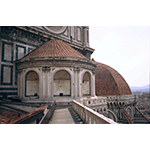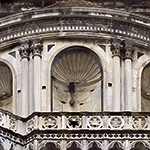The Dome of Santa Maria del Fiore
One of the most significant architectural achievements of the entire Renaissance was undoubtedly the construction, by Filippo Brunelleschi, of the dome over the Florence Cathedral. This work, begun in the summer 1420, was completed (except for the lantern) in 1436.
From the architectural viewpoint, the construction of the Dome of Santa Maria del Fiore represented the event that marked the beginning of the Renaissance, that is, the rediscovery of building models from the classical age and the contemporary changes in the organisation of construction sites, with separation of the roles of designer and builder, a system still in use today. It was the new figure of the designer, exemplified by Brunelleschi, that conferred on architecture the status of an artistic-scientific discipline, from this time on fully entitled to claim its place in the cultural system.
The dome was built without employing centring (a wooden or iron structure) to support the masonry. To achieve this, overcoming the scepticism of his fellow citizens, Brunelleschi devised some extraordinary solutions to lighten the imposing structure and to efficiently organise a worksite capable of fulfilling the requirements of the various stages of construction and guaranteeing the stability of the planes on which the bricks were laid, marked by progressive inclination from the base to the oculus in the dome. To build the dome, Brunelleschi employed innovative machines that he designed himself. The organisation of the worksite and the availability of machines that could move enormous weights and lift them to considerable heights played a decisive role in the construction of the dome. Brunelleschi left neither drawings nor verbal descriptions of the various machines he designed and utilised. However, their exceptionally innovative nature attracted the attention of the greatest engineers of the 15th century (Taccola, Francesco di Giorgio, Bonaccorso Ghiberti, and Giuliano da Sangallo), whose eloquent testimony has survived. Even Leonardo da Vinci drew in his notebooks, with extreme precision, the most important machines used by Brunelleschi to build the dome.
It was only in 1471, with the positioning of the lantern, for which the machines designed by Brunelleschi were used, that the dome could be considered finished. In the spring of 1601 the lantern was struck by lightening that damaged its structure, but was promptly restored.
The structure of the dome is truly imposing. The impost, rising to a height of 35.50 meters above the tambour, is about 54 meters above ground level. The distance between the two opposite edges of the octagonal base is around 35 meters. The height of the lantern that tops it, including the copper sphere, is a little over 22 meters. The inner vaulting cell of the dome has a curve whose radius is 4/5 the diameter of the base, while the outer dome has an inclination whose radius is 3/4 of the diameter. The weight of the dome is estimated as 37,000 tons. It has been calculated that over four million bricks were used in its construction. It is the biggest dome ever built without using centring to support the masonry
Around 1475 Paolo Dal Pozzo Toscanelli constructed a gnomon in the dome, the highest one ever built up to then, which showed the moment when the sun passed through the summer solstice. Toward the middle of the 18th century the gnomon was restored by Leonardo Ximenes, who utilised it to conduct a number of astronomical and physical observations.
****************************
Texts by Graziano Magrini
English translation by Catherine Frost
Last update 15/mag/2008





